 |
|||
|
|
|||
|
Feature Articles: Keynote Speeches at NTT R&D Forum 2016 Vol. 14, No. 4, pp. 1–9, Apr. 2016. https://doi.org/10.53829/ntr201604fa1 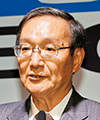
Business Transformation of NTT Group
|
|||
| * | TotalCare is a registered trademark of Rolls-Royce Holdings plc. |
2. Solving social and global concerns
Another important initiative is the use of big data to address social and global concerns (Fig. 3). The idea here is to collect information from all sorts of fields such as transportation, medical care, the environment, agriculture, manufacturing, and education in the form of big data, and to provide it to the world as a public asset for use in solving a wide variety of social and global problems.

Fig. 3. Solving social and global concerns.
For example, transportation and medical care data could be combined to reduce the time needed to transport a patient in an emergency, and environmental and manufacturing data could be linked in order to minimize wasteful consumption of electricity and help solve the energy problem.
This type of inter-industry linkage of information has the potential to create new value. Thinking back to the German and American initiatives mentioned in section 1, we can ask whether Japan should create a mechanism for sharing and using data throughout society. On January 22, 2016, the 5th Science and Technology Basic Plan was approved by the Cabinet Office in Japan. This plan points out current concerns such as the limited supply of energy, the aging population and a low birth rate, impoverished rural communities, natural disasters, changes in the security environment, and various global issues. To solve these problems, we need to promote Japan-oriented usage of IoT and big data. These problems are most striking in regional communities, so this initiative should also lead to regional revitalization.
2.1 Maintenance of social infrastructure
Maintenance of the regional social infrastructure is now a pressing issue in Japan. Tunnels, bridges, roads, and other facilities constructed during Japan’s high economic growth period (from 1955 to 1973) are deteriorating with the passage of time and need to be maintained, and the potential collapse of aged building walls and signboards is also a danger to society. The NTT Group handles the maintenance of utility poles, cable tunnels, and manholes, which are essential to maintaining Japan’s telecommunications infrastructure. Over the years, we have developed and enhanced efficient maintenance technologies such as prediction of facility deterioration through vibration and image analysis as well as rainwater detection. However, if this know-how were to be applied in its present form to the theme of maintaining the social infrastructure, the scope of maintenance operations would broaden immensely. For this reason, it is important that analysis incorporate not just the values detected by vibration sensors and the data provided by image sensors but also other forms of information such as online posts and reports from citizens as big data. In this way, dangerous locations could be identified beforehand, and plans for maintenance and upgrading could be efficiently formulated.
2.2 Self-driving cars
Self-driving cars have been receiving lots of attention of late. In this field too, sharing of data throughout society is essential. For example, if information describing the destinations of each automobile on the road could be shared, AI could distribute the routes taken by those cars in a way that prevents traffic congestion. In addition, if accident reports, road conditions such as icing, and information on emergency vehicles on the road could be shared in real time, not just individual driving but overall traffic could be optimized.
3. Issues in data sharing and usage
There are two main issues in achieving data sharing and data usage throughout society as described above. The first is a data gathering framework that can enrich both the quality and quantity of data. For example, a basic rule in using open data is that the data created from its use must flow back to society as big data and open data to be shared. There is a need here for a neutral institution that serves as a data gathering coordinator so that the gathered data do not become biased toward a particular corporate group or industry. Of course, there will also be a need for various types of data standards and protocols in data gathering.
The other main issue is rule-making for safe and secure data use. The use of data for malicious purposes and the leakage of personal information must, of course, be prevented. Furthermore, in the handling of big data, due consideration must be given to the preservation of anonymity in addition to the application of encryption to prevent spoofing (impersonation) and data tampering. There have been cases in which mixing certain data with other types of data lowers anonymity. In addition, data usage rules covering the purpose of use, the method of use, and the handling of information must be implemented.
While it is necessary to combine and handle diverse types of information to solve social issues, the monopolization of information by a single enterprise would hardly be acceptable. To promote a data-sharing initiative, I believe that local municipalities must take the lead and play the role of a data-handling hub. In particular, a local municipality could merge basic data that it possesses—such as demographic information, map information, and disaster prevention information—with big data gathered via IoT by individual companies and provide that data back to industry as publically owned open data. In this way, diverse types of information can be integrated and used via a local municipality without confining it to a single enterprise, which should vastly expand the possibilities of big data and facilitate the development of regional business. Moreover, as mentioned earlier, feeding back the results of using big data can lead to secondary and tertiary use of big data, which should promote the preparation of open data at an even higher level of quality and quantity. We can expect such locally originated initiatives to vitalize local industry and to contribute to the creation of a Japan-oriented ecosystem. Furthermore, the usage fee of big data in a performance-based manner should promote the use of big data by local startups.
Unfortunately, some companies are considering the resale of data gathered by free Wi-Fi. I have been saying to NTT Broadband Platform, an NTT Group company involved in the Wi-Fi business, that we should not make small change from the primary use of such data. This is because such a way of using data involves privacy issues and hinders the sound development of the use of big data.
4. Enhancement of urban infrastructure by IoT
Two case studies involving the use of IoT are introduced in this section.
4.1 Port of Hamburg
The first case study is the Port of Hamburg in Germany (Fig. 4). The Port of Hamburg is Germany’s largest port, handling more containers than the combined total of the Port of Tokyo and Port of Yokohama, Japan’s No. 1 and No. 2 ports. About 33,000 trucks come and go daily in a site equal to about 1,600 times the space of the Tokyo Dome (4.7 hectares x 1,600: 7,500 hectares), which has led to chronic congestion. The site includes movable bridges to allow large ships to pass, which has also contributed to the congestion. To resolve this congestion problem, all data on the movement of trucks, trains, ships, and other vehicles and that on the raising and lowering of the bridge are now gathered as big data and analyzed, resulting in the optimization of multimodal traffic. In addition, the conveyance of containers and their loading onto trains and other means of transport are automated, with the result that the number of containers handled per hectare is currently more than twice that of the Port of Nagoya, Japan’s most efficient port.
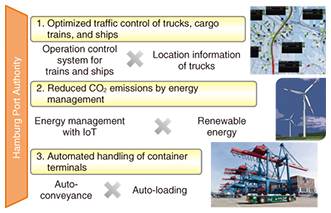
Fig. 4. Case study: Port of Hamburg.
4.2 Enevo Corporation
The next case study is Enevo Corporation in Finland (Fig. 5). In Europe and the United States, it is common for garbage trucks to pick up trash daily from large trash bins placed on street corners. This system adds to traffic congestion and causes various other social problems. Enevo has addressed this issue by using IoT technology to convert the level of trash in each bin to big data so that the trash bins to be emptied can be selected appropriately and optimal routes for trash collection can be created. This method has been provided to local municipalities. As a result, these local municipalities have been able to halve the number of garbage trucks they operate. They have also been able to reduce the number and severity of traffic jams and achieve cost reductions.
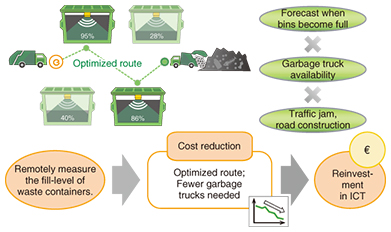
Fig. 5. Case study: Enevo Corporation.
The use of IoT technologies in these ways has helped create a beneficial cycle in which waste is eliminated and the amount of money saved is reinvested in information and communication technology.
5. Collaboration with local municipalities
With the aim of advancing concrete initiatives with local municipalities, the NTT Group concluded a comprehensive partnership agreement with Fukuoka City in April 2015 and a development partnership agreement with the City of Sapporo in September 2015. These initiatives are being undertaken as concentrated case studies toward regional revitalization by exploiting the local characteristics of Fukuoka and Sapporo. The urban scale of both cities involves a sum just under a total of two trillion yen in general accounts, special accounts, and corporate accounts, which we consider to be an optimal urban scale for testing a variety of initiatives.
At present, the port at Fukuoka City has nearly reached saturation due to inbound demand generated by Chinese tourists and other factors, while the City of Sapporo is faced with various problems that need quick attention, as it plans to hold the 2017 Asian Winter Games. In these cities, the aim is to collect big data from companies, citizens, and organizations, accumulate it at the local municipality level, and use the data throughout society as open data. There are expectations that the use of such data in a variety of fields such as tourism, transportation, medical care, and nursing will be promoted and will lead to industrial development, disaster prevention, and public infrastructure management.
However, there are limitations as to what the NTT Group can do on its own here. I look forward to collaborating with diverse players that have already agreed to participate in these initiatives.
6. Security technologies for IoT and big data
In this section, issues concerning data security are explained.
6.1 Data protection
Data protection technologies are essential to the use and application of big data. These include secret sharing and secure computation now under development by the NTT Group (Fig. 6). Secret sharing achieves robust security through the encryption and division of data into pieces that are then stored in multiple servers in the cloud. Secure computation, meanwhile, enables data to be computed and analyzed in that divided state without having to decrypt the data. With these technologies, dividing and storing a set of data among multiple datacenters means that information cannot be leaked even if the data at one datacenter are stolen. It also means that the entire set of data can still be reconstructed even if data at one datacenter were to be lost due to a natural disaster or other mishap. The data can also be analyzed without analysts having to come into contact with the original data.
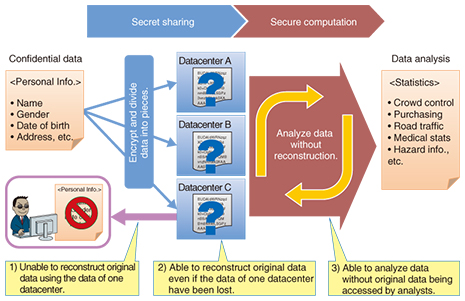
Fig. 6. Data protection technologies.
6.2 Personal data anonymization and analysis
In October 2015, the Special Interest Group on Computer Security of the Information Processing Society of Japan (IPSJ) held its first Privacy Workshop. This event featured competitions that were held focusing on technologies used for handling personal data, and an NTT laboratories’ team won the anonymization and reconstruction competition. In the case of big data, any use of personal data needs to be anonymized, but at the same time, the information itself needs to be analyzed. In other words, there is a simultaneous need for anonymization that conceals data in order to obfuscate the original information, and for analysis that can provide useful information for the real world from the original information.
Security technologies such as these constitute a field that the NTT Group excels at. We aim to become even stronger in this field in collaboration with industry, government, and academia.
7. Information processing technologies in the era of IoT and big data
I previously mentioned the application of big data to self-driving cars. This system requires quick response (real-time characteristics) in order to be feasible. When a traffic jam occurs, local processing is likely to become congested, but since this system functions as a social infrastructure, even a momentary interruption is unacceptable. In response to this problem, NTT is researching edge-computing technology.
Edge computing reduces the response time by the installation of servers at the edge of the network, that is, in the locations nearest the automobiles targeted for processing. When connecting to ordinary Internet servers, the response time is about 100 ms, but with this technology, the aim is to reduce that time to less than 5 ms.
8. The era of collaboration
About three years ago, I expressed the belief that we were entering an era of collaboration. I recently read a book by Professor Takashi Nawa of Hitotsubashi University, which talked about the three layers of competition, collaboration, and co-sourcing (Fig. 7). In the coming era of IoT and big data, I believe that collaboration—the middle layer—will become increasingly important if data sharing continues to expand. Moreover, if collaboration expands in all sorts of fields, competition will take on a more diversified form, and the world may take on an entirely new dimension.
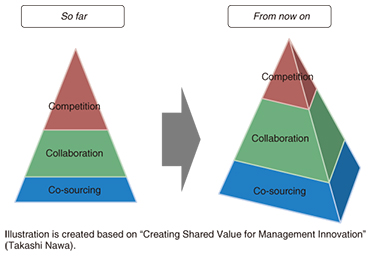
Fig. 7. Era of collaboration.
Incidentally, the focus of the fiber-to-the-home (FTTH) business model of NTT EAST and NTT WEST was redirected from retail sales to wholesale (Hikari Collaboration Model) in February 2015. In other words, the business model was transformed to one that promoted collaboration by enabling other operators to sell FTTH, which had formerly been positioned in the competition layer, in combination with their own services. At present, several players including NTT DOCOMO are rolling out original services combined with FTTH and competing with each other in this way. In the future, we can envision a migration of mobile services as well to the collaboration layer. This collaboration model should stimulate competition in novel services and produce added value.
9. Society 5.0
Japan’s 5th Science and Technology Basic Plan mentioned earlier points out a number of social issues. The government advocates the concept of a super smart society as a means of solving these issues.
The super smart society is defined as “a society where the various needs of society are finely differentiated and met by providing the necessary products and services in the required amounts to the people who need them when they need them, and in which all the people can receive high-quality services and live a comfortable, vigorous life regardless of their various differences such as age, gender, location, or language.”
Such a society will be created by broadening the scope of IoT application beyond manufacturing to a wide variety of fields in order to transform society and by achieving a high degree of merging between cyberspace and physical space (the real world). The government has named this series of initiatives Society 5.0 (Fig. 8).

Fig. 8. Society 5.0.
The 5th Science and Technology Basic Plan calls, in particular, for the development of systems in 11 fields and the building of a common platform for running these systems to achieve a super smart society. It should be easy to see that the aim here is to achieve data sharing throughout society. Incidentally, the notation 5.0 here signifies that the super smart society is the fifth type of society to develop in human history after the hunter-gatherer society, agricultural society, industrial society, and information society.
10. NTT Group CSR Charter
The NTT Group CSR (corporate social responsibility) Charter drawn up in 2006 is shown in Fig. 9. The main theme of this charter is the creation of a safe, secure, and prosperous society through communications that serve people, communities, and the global environment through four types of communication. I was initially a bit unsure of these somewhat abstract declarations, but I now feel strongly that we are on the verge of such an era. As a major direction in its business transformation toward the future, the NTT Group is doing everything in its power to shape communication between people and their communities and between people and the global environment.
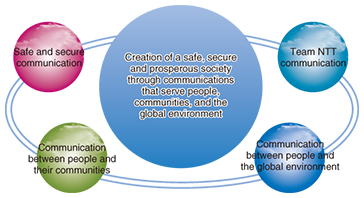
Fig. 9. NTT Group CSR Charter.


